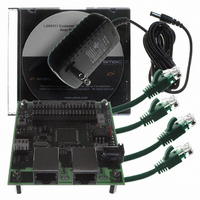EVB9311 SMSC, EVB9311 Datasheet - Page 141

EVB9311
Manufacturer Part Number
EVB9311
Description
EVALUATION BOARD LAN9311-NU
Manufacturer
SMSC
Series
0133r
Datasheet
1.LAN9311-NU.pdf
(460 pages)
Specifications of EVB9311
Main Purpose
Interface, Ethernet
Embedded
No
Utilized Ic / Part
LAN9311
Primary Attributes
2 Ports, 100BASE-TX/10BASE-T, Managed
Secondary Attributes
2 PHYs with HP Auto-MDIX, Auto- Flow Control, 32-bit CRC, MDI/MDI-X
Lead Free Status / RoHS Status
Lead free / RoHS Compliant
Other names
638-1076
- Current page: 141 of 460
- Download datasheet (5Mb)
Two Port 10/100 Managed Ethernet Switch with 16-Bit Non-PCI CPU Interface
Datasheet
SMSC LAN9311/LAN9311i
10.2.2.1
eeprom_size_strap[0]
0
1
controller drives all the address bits as requested regardless of the actual size of the EEPROM. The
supported size ranges for I
Note 10.1 Bits in the control byte are used as the upper address bits.
The I
Philips I
information.
I
I
device that receives data is defined as a receiver. The bus is controlled by a master which generates
the EE_SCL clock, controls bus access, and generates the start and stop conditions. Either the master
or slave may operate as a transmitter or receiver as determined by the master.
The following bus states exist:
2
2
C is a bi-directional 2-wire data protocol. A device that sends data is defined as a transmitter and a
C Protocol Overview
Idle: Both EE_SDA and EE_SCL are high when the bus is idle.
Start & Stop Conditions: A start condition is defined as a high to low transition on the EE_ SDA
line while EE_ SCL is high. A stop condition is defined as a low to high transition on the EE_SDA
line while EE_SCL is high. The bus is considered to be busy following a start condition and is
considered free 4.7uS/1.3uS (for 100KHz and 400KHz operation, respectively) following a stop
condition. The bus stays busy following a repeated start condition (instead of a stop condition).
Starts and repeated starts are otherwise functionally equivalent.
Data Valid: Data is valid, following the start condition, when EE_SDA is stable while EE_SCL is
high. Data can only be changed while the clock is low. There is one valid bit per clock pulse. Every
byte must be 8 bits long and is transmitted msb first.
Acknowledge: Each byte of data is followed by an acknowledge bit. The master generates a ninth
clock pulse for the acknowledge bit. The transmitter releases EE_SDA (high). The receiver drives
EE_SDA low so that it remains valid during the high period of the clock, taking into account the
setup and hold times. The receiver may be the master or the slave depending on the direction of
the data. Typically the receiver acknowledges each byte. If the master is the receiver, it does not
generate an acknowledge on the last byte of a transfer. This informs the slave to not drive the next
byte of data so that the master may generate a stop or repeated start condition.
2
C master interface runs at the standard-mode rate of 100KHz and is fully compliant with the
2
C-Bus Specification . Refer to the he Philips I
# OF ADDRESS BYTES
1
(Note
Table 10.2 I
2
2
C operation are shown in
10.1)
DATASHEET
2
C EEPROM Size Ranges
141
4096 x 8 through 65536 x 8
16 x 8 through 2048 x 8
EEPROM SIZE
Table
2
C-Bus Specification for detailed timing
10.2.
24xx32, 24xx64, 24xx128,
24xx00, 24xx01, 24xx02,
24xx04, 24xx08, 24xx16
24xx256, 24xx512
EEPROM TYPES
Revision 1.7 (06-29-10)
Related parts for EVB9311
Image
Part Number
Description
Manufacturer
Datasheet
Request
R

Part Number:
Description:
FAST ETHERNET PHYSICAL LAYER DEVICE
Manufacturer:
SMSC Corporation
Datasheet:

Part Number:
Description:
357-036-542-201 CARDEDGE 36POS DL .156 BLK LOPRO
Manufacturer:
SMSC Corporation
Datasheet:

Part Number:
Description:
357-036-542-201 CARDEDGE 36POS DL .156 BLK LOPRO
Manufacturer:
SMSC Corporation
Datasheet:

Part Number:
Description:
357-036-542-201 CARDEDGE 36POS DL .156 BLK LOPRO
Manufacturer:
SMSC Corporation
Datasheet:

Part Number:
Description:
4-PORT USB2.0 HUB CONTROLLER
Manufacturer:
SMSC Corporation
Datasheet:

Part Number:
Description:
Manufacturer:
SMSC Corporation
Datasheet:

Part Number:
Description:
Manufacturer:
SMSC Corporation
Datasheet:

Part Number:
Description:
FDC37C672ENHANCED SUPER I/O CONTROLLER WITH FAST IR
Manufacturer:
SMSC Corporation
Datasheet:

Part Number:
Description:
COM90C66LJPARCNET Controller/Transceiver with AT Interface and On-Chip RAM
Manufacturer:
SMSC Corporation
Datasheet:

Part Number:
Description:
Manufacturer:
SMSC Corporation
Datasheet:

Part Number:
Description:
Manufacturer:
SMSC Corporation
Datasheet:

Part Number:
Description:
Manufacturer:
SMSC Corporation
Datasheet:

Part Number:
Description:
Manufacturer:
SMSC Corporation
Datasheet:











